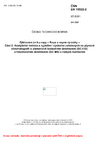ČSN EN 15522-2 (656081) Zrušená norma
Zjišťování úniku ropy - Ropa a ropné výrobky - Část 2: Analytická metoda a vyjádření výsledků založených na plynové chromatografii s plamenově ionizačním detektorem (GC-FID) a hmotnostním detektorem (GC-MS) s nízkým rozlišením
Podívejte se na její náhradu.
Anotace obsahu normy
This document specifies a method to identify and compare the compositional characteristics of oil samples. Specifically, it describes the detailed analytical and data processing methods for identifying the characteristics of spill samples and establishing their correlation to suspected source oils. Even when samples or data from suspected sources are not available for comparison, establishing the specific nature (e.g. refined petroleum, crude oil, waste oil, etc.) of the spilled oil still helps to constrain the possible source(s).
This methodology is restricted to petroleum related products containing a significant proportion of hydrocarbon-components with a boiling point above 150 °C. Examples are: crude oils, higher boiling condensates, diesel oils, residual bunker or heavy fuel oils, lubricants, and mixtures of bilge and sludge samples, as well as distillate fuels and blends. While the specific analytical methods are perhaps not appropriate for lower boiling oils (e.g. kerosene, jet fuel, or gasoline), the general concepts described in this methodology, i.e. statistical comparison of weathering-resistant diagnostic ratios, are applicable in spills involving these kinds of oils.
Paraffin products (e.g. waxes, etc.) are outside the scope of this method because too many compounds are removed during the production process to correctly distinguish them from each other. However, the method can be used to identify the type of product involved.
Although not directly intended for identifying oil recovered from groundwater, vegetation, wildlife/tissues, soil, or sediment matrices, they are not precluded. However, caution is needed as extractable compounds can be present in these matrices that alter and/or contribute additional compounds compared to the source sample. If unrecognized, the contribution from the matrix can lead to false "non-matches". It is therefore advisable to analyse background sample(s) of the matrix that appear unoiled.
When analysing "non-oil" matrices additional sample preparation (e.g. clean-up) is often required prior to analysis and the extent to which the matrix affects the correlation achieved is to be considered. Whether the method is applicable for a specific matrix depends upon the oil concentration compared to the "matrix concentration". In matrices containing high concentrations of oil, a positive match can still be concluded. In matrices containing lower concentrations of oil, a false "non-match" or an "inconclusive match" can result from matrix effects. Evaluation of possible matrix effects is beyond the scope of this document.
| Označení | ČSN EN 15522-2 (656081) |
|---|---|
| Katalogové číslo | 517429 |
| Cena | 1 690 Kč1690 |
| Datum schválení | 1. 9. 2023 |
| Datum účinnosti | 1. 10. 2023 |
| Jazyk | angličtina (obsahuje pouze anglický originál) |
| Počet stran | 222 stran formátu A4 |
| EAN kód | 8596135174294 |
| Norma byla zrušena k | 1. 11. 2025 |
| a nahrazena | ČSN EN 15522-2 +A1 (656081) |
| Dostupnost | skladem (tisk na počkání) |
Další příbuzné normy
ČSN EN 15522-1 (656081)
Zjišťování úniku ropy - Ropa a ropné výrobky - Část 1: Vzorkování
ČSN EN 15522-2 +A1 (656081)
Zjišťování úniku ropy - Ropa a ropné výrobky - Část 2: Analytická metoda a vyjádření výsledků založených na plynové chromatografii s plamenově ionizačním detektorem (GC-FID) a hmotnostním detektorem (GC-MS) s nízkým rozlišením


